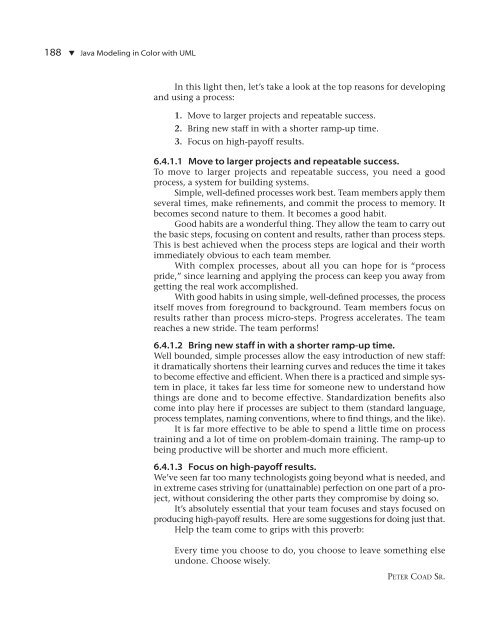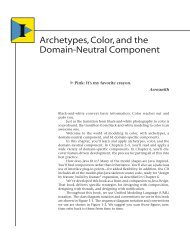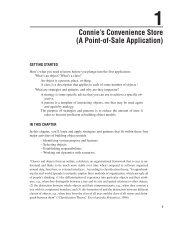Feature-Driven Development - About Peter Coad
Feature-Driven Development - About Peter Coad
Feature-Driven Development - About Peter Coad
You also want an ePaper? Increase the reach of your titles
YUMPU automatically turns print PDFs into web optimized ePapers that Google loves.
188 ▼ Java Modeling in Color with UML<br />
In this light then, let’s take a look at the top reasons for developing<br />
and using a process:<br />
1. Move to larger projects and repeatable success.<br />
2. Bring new staff in with a shorter ramp-up time.<br />
3. Focus on high-payoff results.<br />
6.4.1.1 Move to larger projects and repeatable success.<br />
To move to larger projects and repeatable success, you need a good<br />
process, a system for building systems.<br />
Simple, well-defined processes work best. Team members apply them<br />
several times, make refinements, and commit the process to memory. It<br />
becomes second nature to them. It becomes a good habit.<br />
Good habits are a wonderful thing. They allow the team to carry out<br />
the basic steps, focusing on content and results, rather than process steps.<br />
This is best achieved when the process steps are logical and their worth<br />
immediately obvious to each team member.<br />
With complex processes, about all you can hope for is “process<br />
pride,” since learning and applying the process can keep you away from<br />
getting the real work accomplished.<br />
With good habits in using simple, well-defined processes, the process<br />
itself moves from foreground to background. Team members focus on<br />
results rather than process micro-steps. Progress accelerates. The team<br />
reaches a new stride. The team performs!<br />
6.4.1.2 Bring new staff in with a shorter ramp-up time.<br />
Well bounded, simple processes allow the easy introduction of new staff:<br />
it dramatically shortens their learning curves and reduces the time it takes<br />
to become effective and efficient. When there is a practiced and simple system<br />
in place, it takes far less time for someone new to understand how<br />
things are done and to become effective. Standardization benefits also<br />
come into play here if processes are subject to them (standard language,<br />
process templates, naming conventions, where to find things, and the like).<br />
It is far more effective to be able to spend a little time on process<br />
training and a lot of time on problem-domain training. The ramp-up to<br />
being productive will be shorter and much more efficient.<br />
6.4.1.3 Focus on high-payoff results.<br />
We’ve seen far too many technologists going beyond what is needed, and<br />
in extreme cases striving for (unattainable) perfection on one part of a project,<br />
without considering the other parts they compromise by doing so.<br />
It’s absolutely essential that your team focuses and stays focused on<br />
producing high-payoff results. Here are some suggestions for doing just that.<br />
Help the team come to grips with this proverb:<br />
Every time you choose to do, you choose to leave something else<br />
undone. Choose wisely.<br />
PETER COAD SR.




